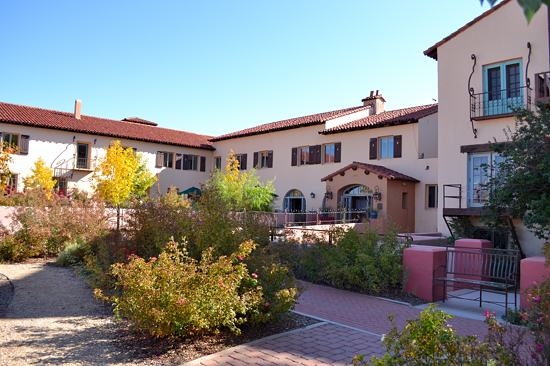
Walk through the gate into the gardens of La Posada, continue up the walkway to the open doors welcoming every traveler, guest and curiosity seeker into this grand Spanish hacienda – the last great railroad hotel built by the Fred Harvey Company. Once you walk through the doors of La Posada you will never believe that culture only comes from Europe. Thanks to Allan Affeldt and Tina Mion; a creative husband and wife team with a passion for art, history and restoration, Mary Colter’s favorite architectural masterpiece continues to live and make a difference in the small town of Winslow, Arizona. Through Affeldt, Mion and their partners in the Winslow Arts Trust, the La Posada is being reestablished as one of the premier hotels and restaurant destinations in the Southwest.
Making its debut in 1930, Mary Colter designed this railroad hotel and many other fine hotels, restaurants and gift shops along the Santa Fe Railroad for the Fred Harvey Company. Colter’s other works include El Tovar Lodge at the south rim of the Grand Canyon and the adjacent Hopi House. Colter was a master at integrating her architectural pieces with the surrounding natural settings as well as paying homage to the culture of the native peoples in the area. Colter’s themes for La Posada was that of a Spanish Hacienda where she brought the outdoors in. Wherever a guest may be in the hotel and its gardens, lawn and trees can be seen through open windows and doorways. It is literally a few steps from any place in the hotel to one of the many gardens on the property including the named sunken garden, potager garden, quince garden, rose garden, and cottonwood grove. Many of the plants have identifying markers for those who enjoy playing amateur botanist. When not enjoying one of the gardens, take some time and play a game of croquet on the south lawn or sit awhile in the rocking chairs overlooking the train tracks and watch the trains roll through or view a beautiful sunset.
Entrance To Sunken Gardens at La Posada
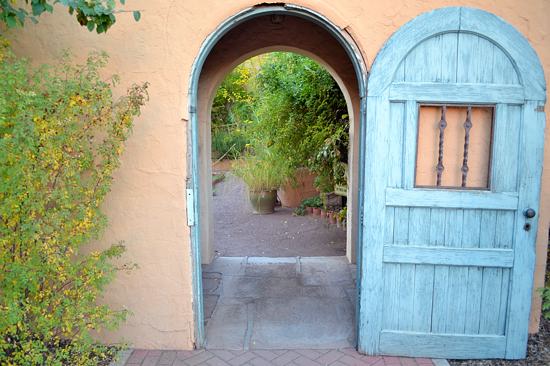
We were attracted to La Posada for a number of reasons. First was location to the Little Painted Desert, the Painted Desert, Meteor Crater and the Petrified Forest National Park. Second, we were looking for an exceptional experience to complete our 3 weeks in the Southwest. Throughout the trip we stayed with generous friends, but mostly in budget hotels. The budget hotel experience served its purpose mainly that of location, functionality and price including a 6 night stay in a nice Howard Johnson’s in Flagstaff for only $42 a night which included a continental breakfast.
Towards the end of our vacation we wanted to splurge a little and were looking for a place to settle for a few days for refreshment, relaxation and meditation upon our long talked about Southwest adventure but also one that would not break the bank. Third, the highly praised Turquoise Room restaurant inside La Posada was the final draw to this oasis in the desert. Nestled inside the hotel, and operated by Chef John R. Sharpe and his wife Patricia, is the exceptional Turquoise Room that the exclusive Condé Nast Traveler Magazine picked as the 2nd best hotel restaurant in the United States. (Look for a separate post coming soon on The Turquoise Room)
La Posada prides itself as not only a magnificent hacienda style hotel in its own right, but it also serves as a museum of local history, fine contemporary art, gourmet local and organic cuisine and a well appointed gift shop. Above all, what stood out to both Alan and I, having traveled considerably in the Southwest at this point were the prices. From the lodging, restaurant, gift shop and more we were struck at how reasonable the prices were compared to other locales for the quality we were receiving. Being in the La Posada is like staying in a mansion and the owners have made it feel as though it is somewhat like your own house you are residing in. The room rates run from $109 to $169 per night. Comparatively, the Best Western in Sedona was priced around $250 per night (Really, for a Best Western? Yep.) so La Posada is a bargain.
Allan Affeldt, Tina Mion and the Winslow Art Trust have many plans for continuing and expanding the La Posada revival and the little town of Winslow, Arizona on famous Route 66. Whether you stay as a guest at La Posada, come for a day tour of the last great historical railroad hotel in these parts, enjoy the architecture of Mary Colter, study the local history, take in the fine art and sculptures, or dine in the elegant yet comfortable Turquoise Room restaurant you are partnering with Winslow Arts Trust in the revival of La Posada and Winslow.
Winslow, AZ is a small town you could easily miss when passing through Northern Arizona, but if you miss La Posada on your way through, you have missed one of the last great architectural and historical railroad treasures the Southwest has to offer.
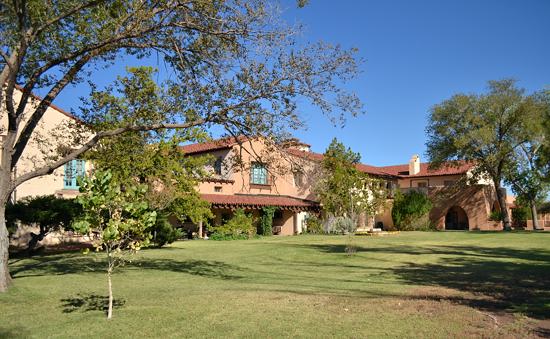
Tags: Destinations, restaurants
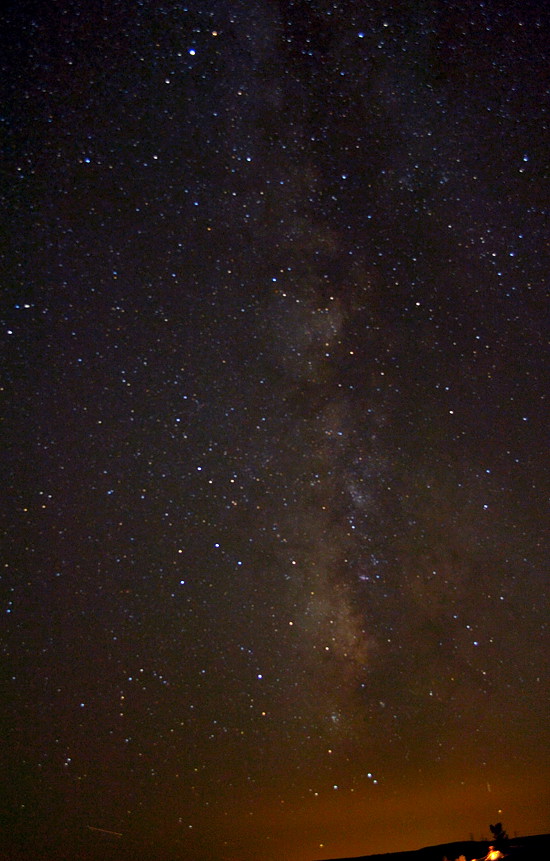
While standing on a corner in Winslow Arizona and seeing a girl in a flat bed Ford checking you out may be such a fine sight to see, standing under the dark desert sky about 5 miles south of Winslow on a moonless night is several notches up from fine, it is spectacular.
Getting away from the lights where we live in Palm Bay Florida is a bit of a task since the proximity of larger population centers like Orlando and the area Melbourne and Palm Bay take up create a lot of ambient glow in the sky. This glow is the enemy of seeing a sky full of stars on a dark night. Sure, you can see several stars most anywhere on a moonless night, but the Milky Way cloud you see in the picture above is a rarity unless you can get away from the ambient light pollution of cities.
However, Northern Arizona population centers are few and far between and the sky is amazingly dark out here. Winslow AZ is approximately 60 miles from Flagstaff and Flagstaff has special street and parking lot lights that limit the light that shines above them (the light is directed downward only plus they have special bulbs) because of Lowell Observatory. And the closest town in the opposite direction is Holbrook which is approximately 30 miles away, and the nice thing for sky watchers is that there is absolutely nothing in between. This makes for a sky that is exceptionally dark when the moon hasn’t risen yet.
The top picture you see above is on a completely cloudless night. What you are seeing besides the individual stars and what looks like clouds, is the spiral arm of the Milky Way galaxy that our solar system resides in. It looks like clouds, but it is actually stars so densely packed (to our perspective) that it just looks like clouds.
With the naked eye the Milky Way glow is somewhat less vivid. Because of the way the digital sensor gathers light and color, what you see in the top picture is not quite as vivid with your own two eyes, but you can see it out here unlike anything I have ever seen in Florida. We found a park called Clear Creek about 6 miles outside of Winslow to the south to get away from the immediate lights of this area and it was quite spectacular as I mentioned before.
For those interested in the camera and settings I used, I have a Nikon D3100 and had the standard kit lens set on 18 mm (to avoid streaking from earth rotation). My f-stop was set at F4 and used an ISO of 800 with a 30 second exposure. The white balance was set to cloudy. Obviously a tripod is essential for this long of an exposure. With a little more experimentation and possibly a different location in the desert it wouldn’t be hard to get even more vivid pictures of the Milky Way. The bottom picture has a less visible galactic cloud in it because in the other direction from the top photo, the ranger station where we were had a flood light on and I wasn’t able to get a long enough exposure.
When you visit the desert Southwest make sure you get the chance to see the stars on a cloudless, moonless night because you may have never seen anything like it.
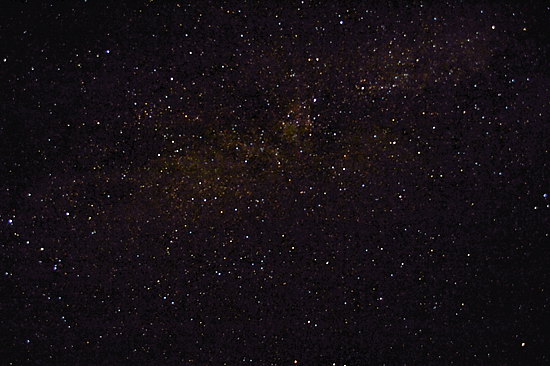
Tags: Destinations, Photography

If you are like Jean and I, almost everywhere we vacation we ask ourselves, ‘Could we live here?’ So far on this trip out in the Southwest no location has struck us as a, this is it place. While Marble Canyon has its solitude and Flagstaff has its great location and beautiful scenery, we hadn’t happened upon the perfect town, that is until yesterday when we drove out of the forest of beautiful Oak Creek Canyon and cast our eyes upon Sedona, Arizona.
If ever there were a nearly perfect place that you may want to live, it could be Sedona, AZ. Quite literally from the moment we drove past the Welcome To Sedona sign we both absolutely fell in love with this place. The lush mountain forests with red rock spires jutting up above the greenery, the beautiful views from just about any place in town, the multitude of things to do here and the architecture that blends buildings right into the landscape of this area are all completely captivating. The only thing that isn’t captivating is the $300,000 average price for a home here. That may be one reason only 11,000 people have chosen to make Sedona their home.
Never mind the steep price for housing, our day began with a drive out to Chapel Of The Holy Cross a small, but amazing church built right into the red Navajo sandstone of the mountains. It took nearly an act of Congress to get this church built because it resides in one of the most picturesque locations in the city. The view from the chapel is nothing short of spectacular and it is well worth visiting.
Chapel of the Holy Cross

We next grabbed some lunch and were heading out to Crescent Moon Ranch to get a good look at Cathedral Rock, but found an ideal hill overlooking the Cathedral spires and avoided the $9 charge per car to get into the park. Not only was this the perfect spot for a picnic, it was amazingly clean, as is the rest of Sedona. It is remarkable that we were out in the middle of nowhere a few miles from town in a place where people had obviously parked their vehicles and walked up the hill and there was no trash, as in none. That was another thing we loved about Sedona, even for all the tourists that come through here (as Jean and I did) the place is nearly spotless clean. It is as if everyone goes above and beyond to keep this place tidy. We even noticed several businesses that had people sweeping sidewalks and parking lots, picking up trash in a Disney, spit-shined sort of way.

We next visited Exposures Fine Art Gallery featuring top quality art from only world class artists. If you have ever picked up any art magazine that featured the best of the best, some of their art is probably on display here. Everything in the gallery is beautiful, of the highest quality art and is priced in the thousands to hundreds of thousands of dollars. It is almost intimidating to walk through Exposures as an art concierge (there’s probably a better term) follows you around. I’m sure they do that to keep en eye on the riff-raff, and with our nearly clashing Tye-dye shirts, I’m sure Jean and I appeared to be riff-raff to the staff (Did I almost make some poetry there?).
After spending several hours in Sedona, it was time to drive back to Flagstaff and as we were heading out of town, I said to Jean, “Do you think they’d mind if we drove about 5 mph all the way through town just to take it all in?” It really is that beautiful here. We did stop one more place as we were leaving when we noticed a Starbucks overlooking a beautiful red rock cliff formation and hung out for about an hour as we grabbed a tea and sat on the porch overlooking the mountains.
If Jean and I ever skip town, the first place to look for us would be in Sedona, Arizona.
Tags: Destinations
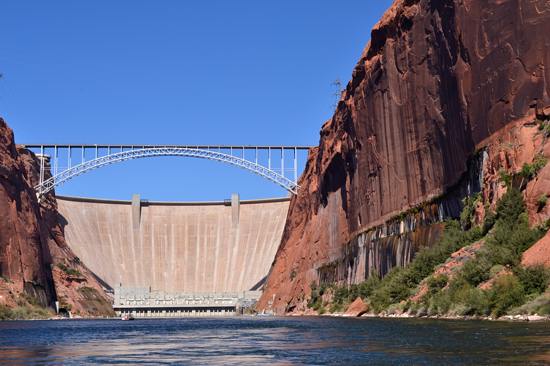
When one thinks of Colorado River rafting, images of whitewater rapids, getting soaked from head to toe and sometimes getting thrown from your raft come to mind. However, that wasn’t our experience when rafting down the Colorado in Glen Canyon. Colorado River Discovery offers what they call half day river floats that are calm water the entire trip and allow you to take your camera and get some great pictures or just enjoy a leisurely rafting experience without getting wet.
While you are not exactly on the river for a half day, your entire trip will take half of your day by the time you get to the river and then take an hour ride back to Colorado River Discovery’s headquarters. Your journey begins with a trip down the 2 mile long Glen Canyon Dam access tunnel as you are plunged into almost complete darkness for 5 minutes. The access tunnel is not open to the public because it is a Department of Homeland Security site and only certain rafting companies are allowed access. Because it is a secure site it also requires that your bags be inspected and of course you can’t bring any weapons of any kind including your Swiss army knife.
Once you are in the water, your guide will move their raft back a little so you can get a good look at the entire scope of the 710 foot high Glen Canyon Dam, the 4th highest dam in the United States. As you meander down the Colorado River for 9 miles you will see incredible changing geology and sheer cliff walls that range in height from 700 feet to almost 1,500 feet. You will also see some amazingly well preserved petroglyphs left by native Americans some 4,000 years ago. You are allowed within just a few feet of these archaeological treasures, but are given a stern warning not to touch them or leave your own graffiti behind as some foolish travelers have done. One not so brilliant venturer was fined $20,000 and had to pay for restoration because he defaced the petroglyphs with his initials.
Petroglyph Site
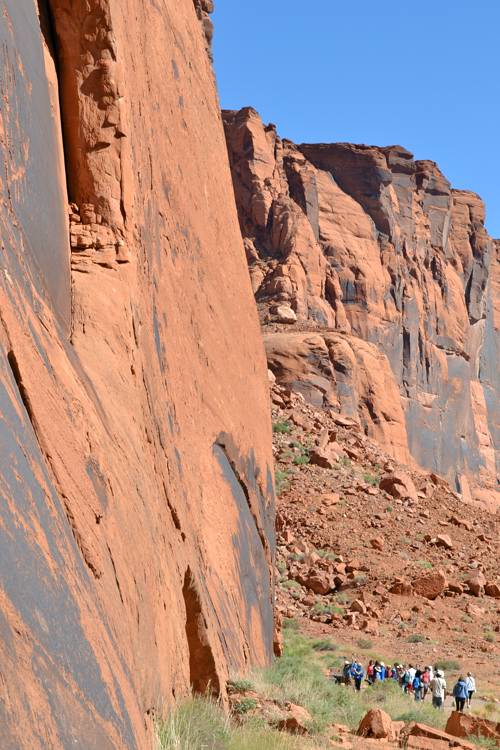
4,000 Year Old Petroglyphs
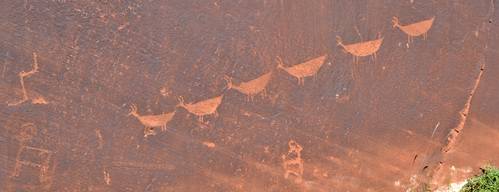
One of the more dramatic sections of Glen Canyon is the well known Horseshoe Bend where the Colorado River snakes around a peninsula of land 270 degrees. Horseshoe bend is actually much more dramatic from above than down in the river and fortunately you can stop at the overlook off of highway 89 near Page Arizona (where Colorado River Discovery resides), walk the 3/4 mile path to the overlook and see a birds eye view of this natural wonder. You will see a stunning view from the overlook, but be ever so careful from this vantage point because there are no guard rails anywhere and there are plenty of places to walk right up to the edge and drop straight down 1,400 feet to the river below.
Horseshoe Bend Overlook
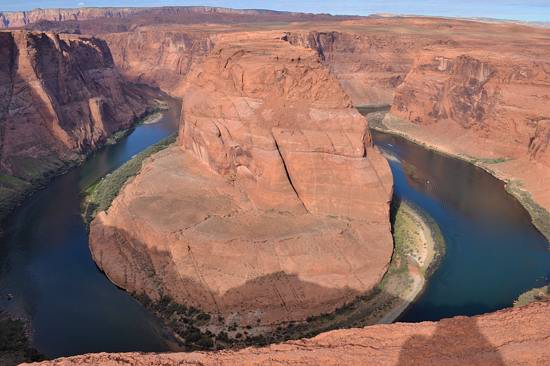
Your 9 mile rafting trip finally ends at Lee’s Ferry in Marble Canyon which although it is a man made barrier, it is officially where the Grand Canyon begins. It is also where rafters that are going down the Grand Canyon for 2 to 3 weeks leave from and it is the only place where you can drive your car down to the Colorado River for a 700 mile stretch.
Seeing the Colorado River from this vantage point while actually being on the river and experiencing the dramatic sheer cliff walls, seeing the ancient petroglyphs, waving to the fly fishermen, seeing the abundance of geology (and having a guide to explain it to you) is the only way to really get the full effect of Glen Canyon and the mighty Colorado. It is also a photographer’s dream because you could almost never run out of subject matter with the changing light, seasons, moods and weather of what nature has in store here.
Experience rafting the Colorado River as soon as you can and make sure you bring your camera.
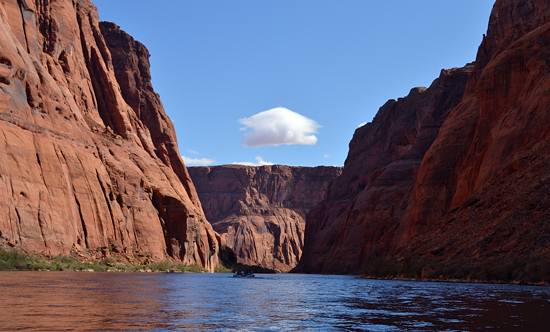
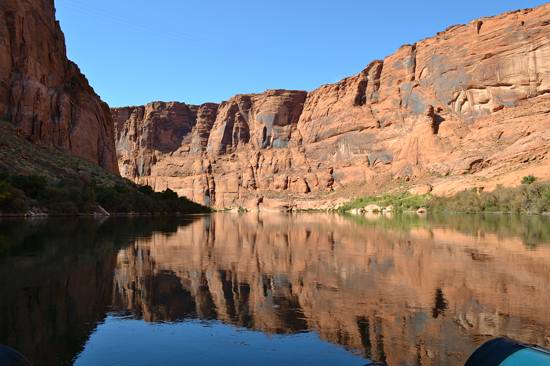
Tags: grand canyon, Photography
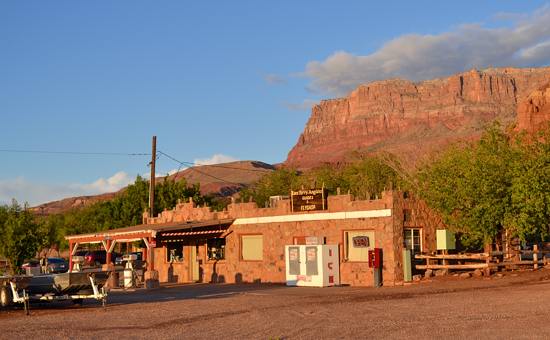
After spending the first several days of our southwest vacation in colorful Colorado, the Centennial State, the next leg of our journey took us to a more remote location in Arizona called Marble Canyon. Marble Canyon feels like it is out in the middle of nowhere and from the fellow travelers we ran into, that was exactly the way they wanted it. Cliff Dwellers Lodge is one of about 3 small hotels, or lodges as they are called in these parts, located just 9 miles west of Lees Ferry and the Navajo Bridge where US Highway 89A crosses the Colorado River.
Cliff Dwellers sits right at the foothills of the Vermilion Cliffs looming behind and Echo Cliffs before. There is nowhere your eyes can see for 360 degrees that you will not have breathtakingly beautiful views of red Navajo sandstone cliffs. Throughout the day, from dawn to dusk, the sun and shadows play across the marble like cliffs creating a variety of colorful effects.
It is at the juncture of this part of the Colorado River that the Grand Canyon officially starts. This makes Cliff Dwellers Lodge an excellent location to take a day trip out to the north rim of the Grand Canyon. In an approximately 2 hour drive from the lodge you can begin hiking the north rim. The north side is spectacular and as one fellow traveler we met along the way encouraged us to go see it because – “There’s only one North Rim.” He was right and we are so glad we took his advice and made the trek out past Jacob’s Lake across the Kaibab plateau.
On your way to the north part of the canyon you will have more incredible views as you climb to the 8,000 foot elevation up Kaibab Mountain. Make sure you stop at the scenic overlook featuring the Vermilion Cliffs and the vast green plain below. This is a condor release location, so get your binoculars out and see if you might spot one of these rare raptors. Though with a 9 foot wing span you may not need the binoculars at all.
Getting back to the lodge we stayed at, it is also an excellent location to venture out to Lees Ferry where there is a National Park ranger station and campground. It is the only place in 700 miles where a traveler can drive right up to the Colorado River. Lees Ferry is where Colorado River Discovery rafting trip ends their journey and takes out (look for an upcoming post). At Lee’s Ferry is the original Navajo Bridge, an engineering marvel for it’s time, which spans the Colorado River. Since the new bridge was built, the original bridge spanning the Colorado River was decommissioned but is open for pedestrian traffic only, so bring your camera!
Navajo Bridges, Old and New, Over The Colorado River
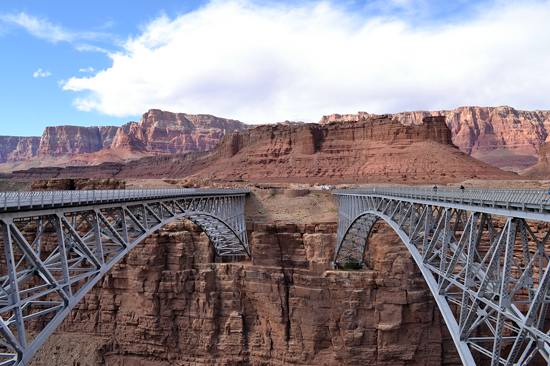
It is pretty obvious that Cliff Dwellers Lodge is in an ideal location to make your vacation base for enjoying many of Northeastern Arizona’s finest natural geological formations – cliffs, canyons, plateaus, meadows, mesas and buttes not to mention the wild flora and fauna that abounds in these remote parts of Arizona. There is also an amazing amount of American history to take in, especially American Indian history and culture.
Cliff Dwellers boasts a friendly staff that works to accommodate your preferences and needs. When we checked in we discovered that another room had a more preferential view for our tastes and the host on duty very willingly accommodated us and let us switch rooms. We preferred the rooms with the front porch facing the Echo cliffs. While staying at Cliff Dwellers you will want to take advantage of the dark night sky. On a clear night you can see the constellations spanning horizon to horizon something you will never see near any moderately sized city. Can you say billions and billions of stars?
Of course the most popular reason many people stay at this remote lodge is for the outstanding trout fishing. If you are coming to Marble Canyon, Lee Ferry Anglers at Cliff Dwellers Lodge is the place to make your home base for however long you might be in the area – In less than 10 years Terry and Wendy Gunn have grown their business into the largest fishing guide service in the US.
Cliff Dwellers is a down home place to make your vacation base while touring the southwest. Whether you plan to hike, raft, fish, or take pictures, the proprietors will do all they can to make your stay a comfortable one. Don’t expect lots of amenities – this is back country lodging. But do expect really good food at the semi famous restaurant and friendly people who make you feel right at home whether you are traveling through or staying a while.
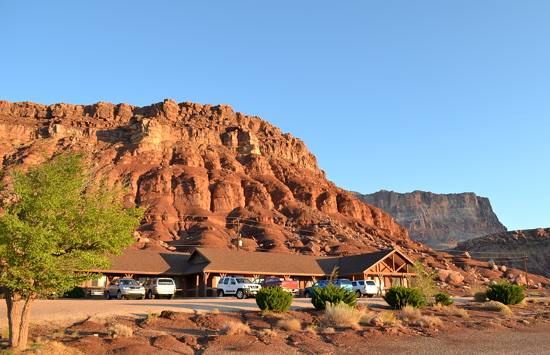
Tags: Destinations, grand canyon
